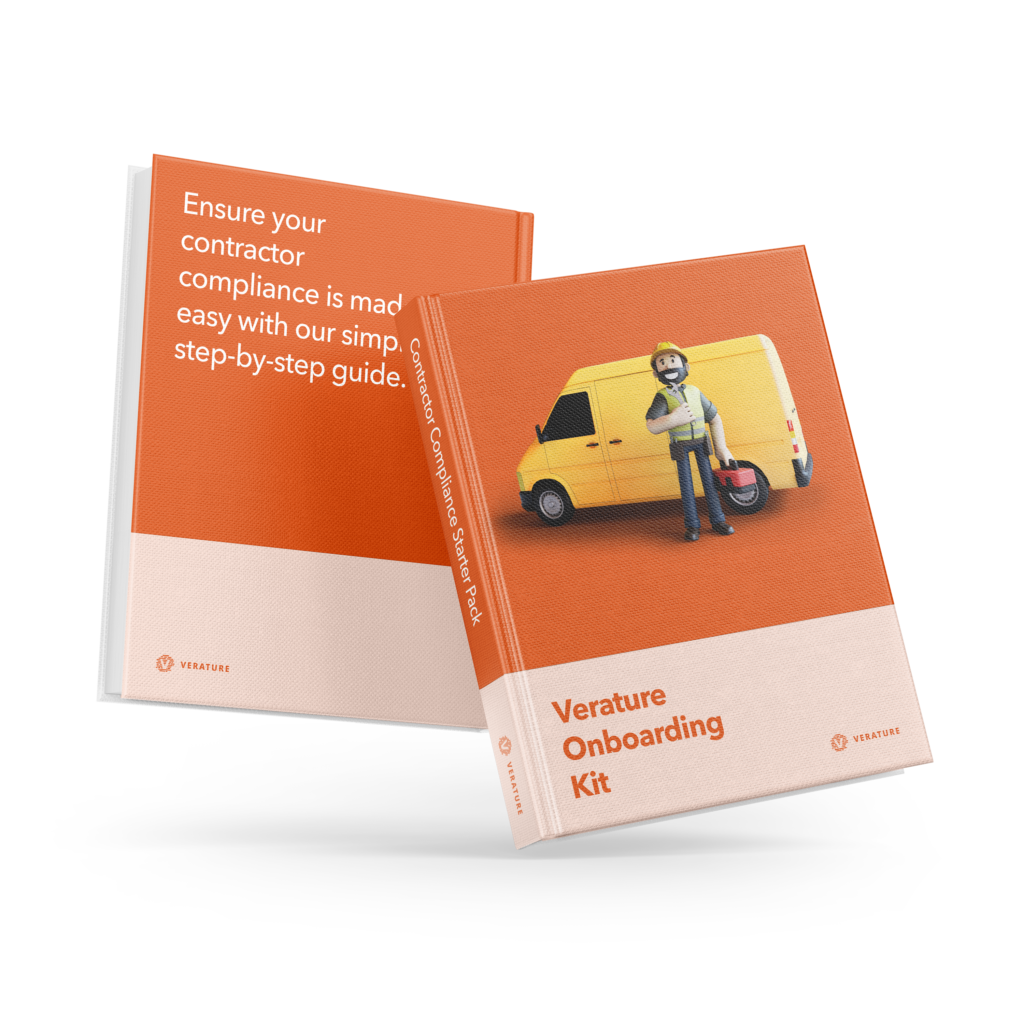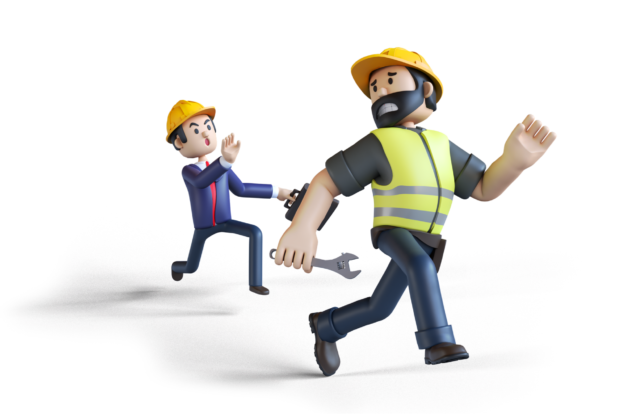- Why Verature?Find out why Verature is the best system for continuous contractor compliance.
- Arrive, Work & Stay Safe
- Removes Paper & Spreadsheets
- Tracks Key Contractors
- Instant 360 Visibility
- Contractor Management Dashboards
- Why Contractor Management Software
- Our Customer Reviews
- Pricing
We don’t hide behind fancy sales teams before we tell you, our prices.- Clients
See who we are working with and what they have to say about Verature.- Resources
Check out our blog, useful guides, whitepapers and product videos.- Prequalification and Induction Guide
- Contractor Compliance Guide
- Mini-Audit your Permit to Work System
- Health and Safety Audit Checklist
- Resource Library
- Blog
Book a demo
How to Boost Contractor Compliance in 5 Steps
We have identified that organisations find that contractor compliance is one of their biggest health and safety challenges. Finding the time to manage every aspect of a contractor coming onto site has been found to involve a lot of chasing for paperwork to be handed in or completed, and sometimes organisations will cut corners to relieve themselves from the workload, so how can you ensure contractors comply with your health and safety requirements?
Here are our 5 steps to boost contractor compliance and safety to help keep your organisation compliant and ensure everyone on site stays safe and healthy.
1. Plan the requirement of the job
Contractor compliance starts with knowing exactly what your project involves and what you need from a contractor. You need to make sure you have a clear and detailed project plans and job requirements before work begins. Planning and assessing is vital in helping you choose the right contractor and communicating requirements and any hazards should be eliminated or minimised before work begins and safe systems of work should be put in place.
2. Ensure you have the correct contractors.
Spend some time researching and getting to know contractors. You need to collect data about your contractors and subcontractors to understand if they a good work record and a sound reputation, as well as the correct accreditation in the required field. Take the approach of a pre-qualification process to ask specific questions, as well as request documents such as certifications and insurances.
Questions to ask:
- Is the contractor a member of a professional, regulatory body?
- Can the contractor provide positive references from previous projects?
- Does the contractor have a rigorous health and safety policy and details of how it puts the policy into action?
- Does the contractor keep up-to-date staff training records and details of Continuing Professional Development (CPD)?
Pre-qualifying your contractors means you can choose the one best equipped to meet your needs and the requirements of the project but also evidence your stand on contractor compliance. Using your project plan and pre-qualifying your contractors you can ensure that the contractor can meet all requirements for safe work before beginning on site.
3. Create inductions to ensure contractors feel at ease on site.
Contractors often work in unfamiliar settings so strong lines of communication are key throughout a job to ensure workers are aware of any hazards and feel comfortable in their working environment.
Ensure there is an induction process for contractors to help collate key information that the contractors need. The induction should include: safe systems of work, site info and map, welfare facilities, Personal Protective Equipment (PPE) requirements, emergency procedures and key contacts.
We find that some companies run their induction process alongside their pre-qualification process to ensure contractors are inducted compliantly by, providing an online induction video followed by an online induction questionnaire for contractors to complete before they are allowed to come onto site – site access and scheduled work would be then based on their contractor information and their pass score in the induction process.
4. Now you’ve reduced bottlenecks, its time for them to come site
Make sure you always know when contractors are on site: schedule and book work programmes ahead of time. Completing the induction process prior to coming on to site, the benefit your company has is reducing bottlenecks in your reception area, and now you can ensure only compliant contractors have access to your site.
Enable contractors to sign in and sign out. When contractors are on site, you need to make sure they are added to your fire register in case of any instances, and there should always be clear safety signage to help contractors navigate safely around site and remind workers of PPE obligations that were shown in their induction process.
We have helped companies with their contractor sign in and sign out process by developing Kiosk variations to meet business needs. We developed our systems to manage how visitors and contractors sign in or out of site with three different Kiosk modes; you can now choose between a quick and click sing in and out procedure, or scan your badge via unique QR code to sign in and out, or search your name to sign in and out. All providing the security organisations may need when someone is not there to manage it.
5. Monitor, follow up and review
Once your contractors on site, it is important to make sure you know who is responsible for monitoring contractors. Even with a thorough risk assessment and project plan, open communication needs to continue throughout the job. Projects evolve, requirements get updated and working conditions can change. Monitoring contractor progress and maintaining regular communication will ensure everyone is up-to-date and will boost contractor compliance going forward.
Health and safety, and compliance performance should be monitored consistently so you need to keep up to date records of the contractors, and make sure to set expiry dates and notifications to keep in touch with your contractors to efficiently manage their data you collected at the beginning and therefore any failings should and can be addressed swiftly.
If you’re happy with their work and the contractor maintained good health safety compliance throughout the contractor on-boarding process and project, you can add them to your approved contractors list for future jobs.
How are you dealing with contractors?
As the government encourage us to go back to the office, it is important to consider new ways of maintaining compliance and managing contractors and look towards the future and perhaps the offering of digital contractor on-boarding systems, so you and your team can continue to work efficiently and collaboratively with your supply chain and contractors to evidence contractor compliance.
The HSE have been maintaining regulatory oversight of how duty holders are meeting their responsibilities in the context of the current public health risk and will be carrying out work to check that appropriate measures are in place to protect workers from COVID-19, and will resume targeted proactive inspection work of high-risk industries – therefore, contractor compliance should be on the top of your agenda for your return to the workplace.
Employers have a legal obligation to ensure all employees and contractors are aware and comply with current legislation to carry our work on site. Approval would normally depend on criteria such as site inductions, adequate and current insurance, compliance with environmental and health and safety policies. You can keep on top of contractors with improved and automated information management systems to ensure they don’t make costly mistakes. Improving contractor compliance and job audits more effectively means organisations have everything they need to know about their workers to evidence due diligence.
For more info on this topic, view our comprehensive guide on Mastering Contractor Compliance, Workplace Safety, and Document Management
Get in touch now for a quick initial chat or arrange a free, informal, no-obligation tour of Verature over a webinar to see how our contractor management systems can bring these five steps for contractor compliance to fruition.
Book a demoFind out if you’re ready with our Verature Onboarding Kit
Not sure if Verature is right for you? We understand it’s not easy to make a decision on a new system, but that’s why we’ve created our Onboarding Kit to make that that process simple.
Check our package details
Find out no matter what package you choose, you’ll be getting the best features you need for you and your team so you can have continuous contractor compliance.
Make it your own
You’ll get to see and choose your customisation options, and check out the available add-ons and extras so the system is exactly what you want and need.
Quickly getting you started.
Keeping this guide with you, and working closely with us, we can walk you through each step so you can be completely up and running with your own Verature system.
More reasons to use Verature
It’s easy to get started.
Step 1
Book a demo of Verature with the team.
Step 2
We’ll chat through your requirements and see if Verature is right for you.
Step 3
We’ll send you demo access and our onboarding kit to help you decide what you need.
Step 4
You decide if we’re right for you. No pushy sales calls.
Step 5
Like what you see and hear? Let’s get you onboarded with Verature!








